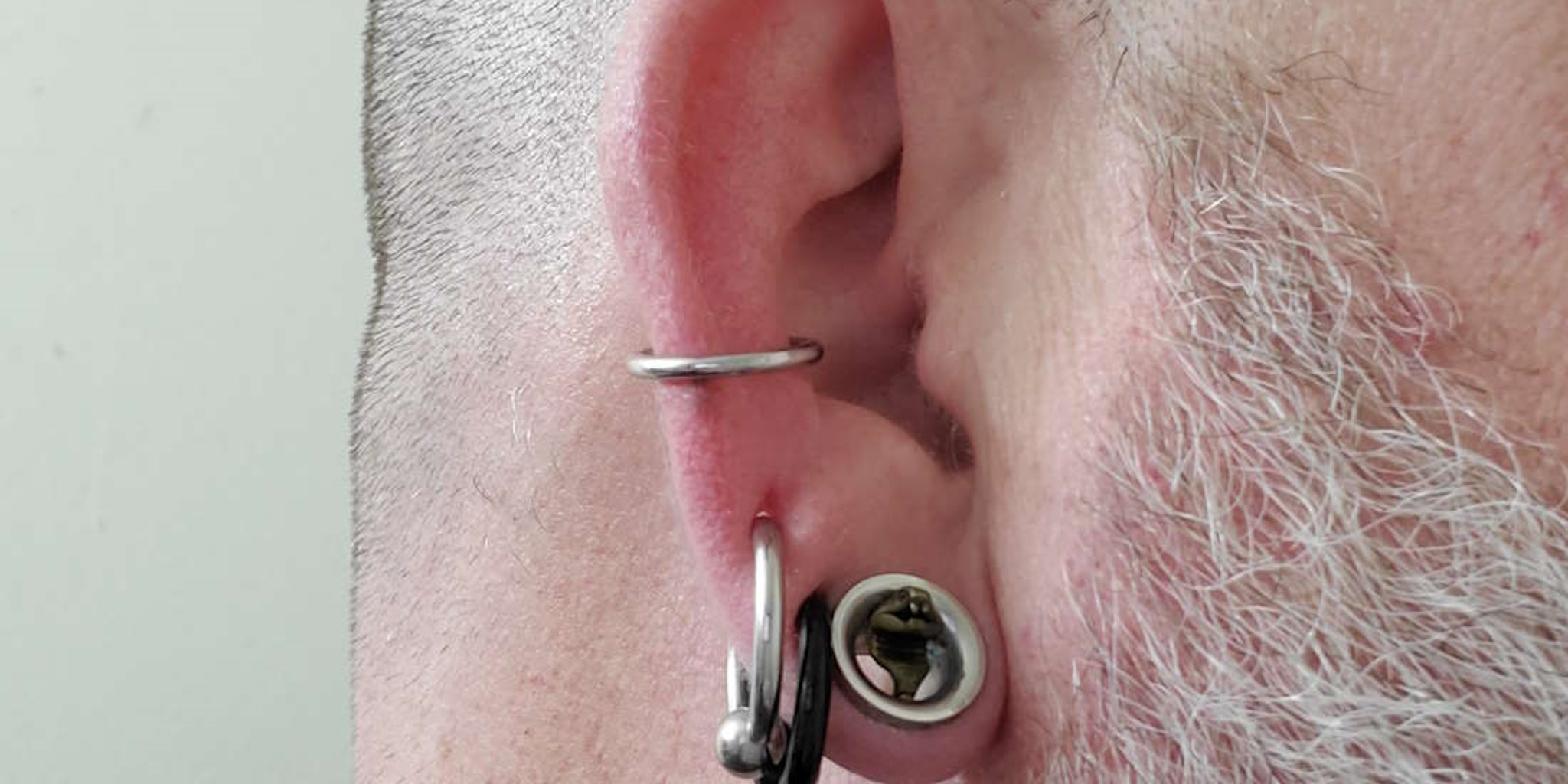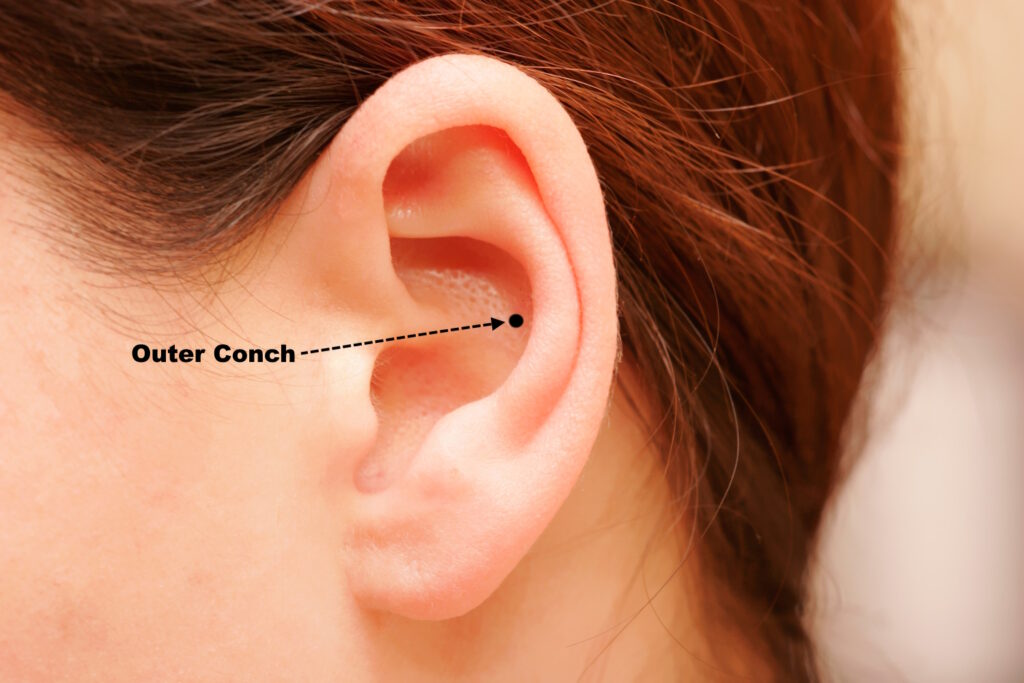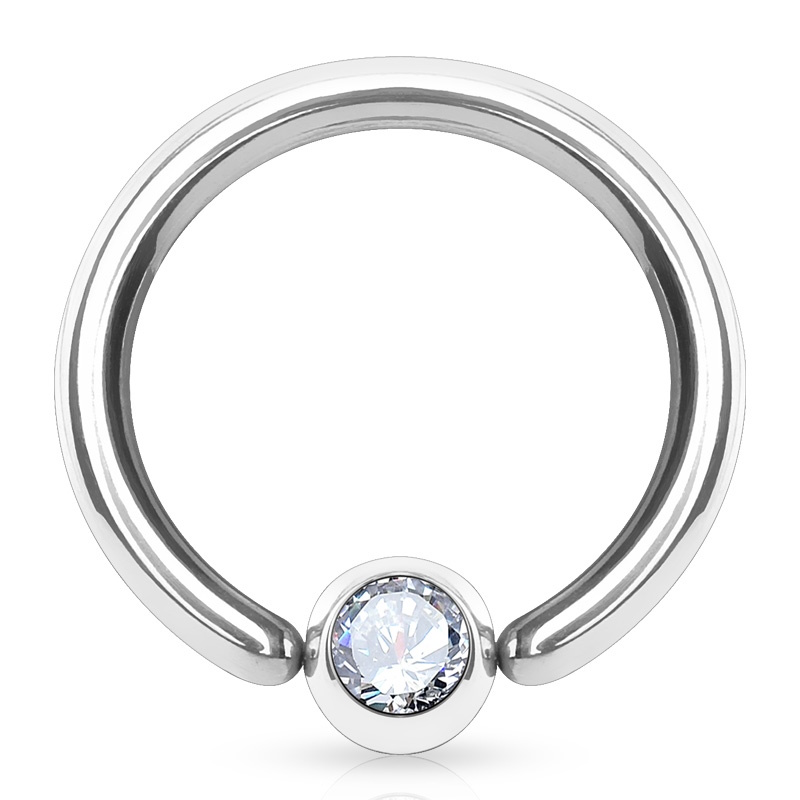
Outer Conch Piercing: A Guide For The Fashionable Rebel
Outer Conch Piercing Article Quick Reference:
History | Myths | Complications | Pain | Cost | Procedure | Healing | Aftercare | Jewelry | Celebrities
The outer conch piercing – the piercing that is all the rage among the cool kids. This piercing goes through the uppermost and thickest part of your ear’s conch cartilage, which means it’s no joke. But hey, who wants a boring piercing in the soft part of their ear when you can have a badass one near the edge where the conch meets the helix?
By chance, if you are wondering where the conch meets the helix, you can find the precise location on the diagram below.

A LITTLE HISTORY ABOUT THE OUTER CONCH
The outer conch piercing is not a piercing that’s just a trendy fashion choice, but also holds significant religious and cultural importance! Who knew jewelry in a little conch could be so powerful?
In Hinduism, believers attribute enhanced hearing abilities to the left outer conch piercing, as well as its ability to ward off evil spirits. Plus, it’s just a cute way to express your femininity! We all know that a little bling can go a long way, especially if it has mystical powers.
Meanwhile, in Buddhism, the outer conch piercing is all about spiritual enlightenment and wisdom. It appears that conch shells play a crucial role in religious ceremonies, and piercing your conch aids in aligning with deeper levels of conscious awareness.
Native American cultures hold the conch shell in high esteem, as it represents the sounds of creation. By extension, the outer conch piercing symbolizes a deeper connection to the earth and spiritual awareness. Pretty deep stuff for a little piercing, right?
And finally, in today’s modern times, the outer conch piercing is just a fun and stylish way to show off your individuality and express yourself. Whether you’re in it for the cultural significance or the aesthetic appeal, there’s no denying that the outer conch piercing holds a title for being one swell little ear piercing!
MYTHS & MISCONCEPTIONS
People often confuse common myths and misconceptions about an outer conch piercing. Here are some of them:
- It Will Damage The Cartilage Tissue: This is a common misconception as piercing an outer conch doesn’t cause cartilage damage. Instead, piercers perform this piercing using a hollow needle, creating a clean, precise hole, which reduces pain and speeds up the healing process.
- It Always Hurts: Not necessarily; it varies from person to person. Every piercing could be hardcore or a piece of cake with proper treatment and care, pain subsides within a few days (a small price to pay for sleek ear fashion, we reckon!).
- It Can Lead To Infections: Piercing any part of the body comes with risks of infection, but following proper aftercare methods, like keeping the area clean and avoiding irritants, can reduce the risks.
- It Takes A Long Time To Heal: Healing time – a topic of focus for oh-so-many. Generally, it takes around 3 to 12 months to regain full comfort with your outer conch. Other factors may affect the healing time also including your immune system, lifestyle, and care, so be patient, it’ll be worth it.
- It Limits Daily Activities: Forget about it! Once healed, the sky’s the limit – go swimming, run a marathon, or style your hair however you fancy! Nothing can stop you!
A BATTLE OF THE SEXES, AGES & CULTURES
Firstly, we’ve noticed that people aged 18 to 30 have their fair share of outer conch piercings, but don’t get it twisted – everyone is welcome to the hip kids’ club! Your age won’t stop you from getting a piercing unless you are under 18.
Professional piercing studios usually advise waiting until the age of 18 or when the body is fully developed before getting an outer conch piercing. However, some piercers will allow younger people with parental consent, so don’t worry, teens, if you have mom or dad’s blessing, ear bling is coming your way!
Now, we need to talk about gender division – it’s a popular choice among females, but men are catching up and rocking this awesome style. Breaking stereotypes, one piercing at a time!
Lastly, as far as culture, Hindus and Buddhists are more inclined to this piercing style, making outer conch cuts super on-trend within these communities!
THE RISKS OF AN OUTER CONCH
Like any other piercing, there are some risks and complications associated with getting an outer conch piercing. Here are some of the possible risks:
- Infection: Piercing any part of the body comes with the risk of infection, and the outer conch is no exception. Infection can occur if proper aftercare methods are not followed.
- Allergic Reactions: Some people may be allergic to certain types of metals like nickel, which can cause an allergic reaction when wearing jewelry. It’s important to choose jewelry made from metals that are hypoallergenic.
- Keloids: Some people may develop keloids, which are raised scars that form around the piercing. They are usually not harmful, but they can be cosmetically unappealing.
- Nerve Damage: Don’t worry; that piercing needle can’t hurt you, but it could nick a little nerve – oh dear! Avoid a shock and get a professional to save those ear nerves.
- Bleeding: Remember, the piercing and healing processes may cause bleeding, but if it’s too much, that’s something to worry about, so keep the gauze handy!
- Migration And Rejection: There is a slight chance that the body may not tolerate the foreign object (jewelry), leading to migration and rejection of the piercing.
THE COMPLICATIONS OF AN OUTER CONCH
Before getting an outer conch piercing, there are also several medical conditions you should consider to ensure that the piercing is safe and does not exacerbate any existing health conditions. Here are some of them:
- Blood Disorders: If you have a bleeding disorder like hemophilia, you might want to think twice about getting your conch pierced. You don’t want to bleed out just to look cool, right?
- Diabetes: Diabetic patients have a higher risk of developing an infection. It is, therefore, advisable to take extra precautions, such as ensuring proper blood glucose control and following strict aftercare methods like keeping the wound clean and dry.
- Skin Conditions: Have some pesky skin issues like eczema or psoriasis? Unfortunately, an outer conch piercing may worsen those pesky skin conditions, so make sure to talk to your doc before you get poked.
- Immune System Disorders: Individuals with immune system disorders such as HIV/AIDS may have a lower immune system function, making them more prone to infections.
Overall, it’s always smart to chat with a pro-piercer or your doctor before getting any piercing, especially if you have any medical concerns. These folks will give you the best advice on how to care for your piercing after getting the go-ahead. So be safe, be fabulous, and happy piercing!
AM I STUCK WITH MY OUTER CONCH PIERCING?
Do you have an outer conch piercing and wonder what would happen if you remove the jewelry? Here’s the inside scoop:
The good news is that you can definitely take out the jewelry and have the piercing reversed.
But how long will it take to heal? Well, that depends on a few things, like how long you’ve had the piercing, the size of the hole, and how well you took care of it. If the piercing has only been there for a hot minute, the hole might close up on its own. But if you’re talking about a more established hole, then you might need to give it some time to heal.
Now, if you’re thinking that once the jewelry is gone, the hole will disappear entirely, we gotta warn you, that’s not always the case. Sometimes, the hole can still be visible for years after the jewelry is out, like a tiny, rebellious dot on your ear. And if you’re really determined to remove it entirely, you may need to consider surgery or other cosmetic procedures like microdermabrasion. But that’s a conversation for another day.
TAMING THE OUTER CONCH PIERCING
First things first, the amount of pain you’ll feel is different for each person and can depend on a few factors, like pain tolerance, anxiety, and the skills of your piercer. But don’t worry, it’s all over pretty quickly! A few seconds of discomfort for a lifetime of style, baby!
Most people feel a sharp pinch or pressure when the needle goes through the cartilage. The pain isn’t so bad that you’ll wanna shout “ouch!” for hours on end though. Just a brief moment of “ow” that you’ll get over soon. Afterward, you might experience some throbbing or tenderness, but nothing that compares to the pain of, say, stubbing your toe.
Now, if you’re still feeling some discomfort, fear not! Here are some ways to manage the pain:
- Pain Medication: Pop some pain relievers like acetaminophen or ibuprofen, but steer clear of aspirin because it thins your blood and therefore increases your risk of bleeding.
- Cold Compress: Use a cold compress on the area to reduce swelling and numb the pain. Just wrap some ice up in a clean, soft cloth and place it gently on the piercing.
- Rest: Take it easy, folks! Give your piercing some TLC and avoid any activities that could make it worse or hurt like hell.
And remember, if the pain persists, hit up your piercer or a healthcare pro for some extra advice. Don’t suffer in silence!
PRICING AN OUTER CONCH PIERCING
Would you like to know the price of an outer conch piercing? Well, let’s just say it’s not gonna be chump change! Here’s the lowdown on the expected costs based on where you’re at in the US:
- West Coast: If you’re feeling fancy and vibing on the West Coast in cities like Los Angeles, San Francisco, or Seattle, you’re lookin’ at a price range of around $50 to $80 for that precious outer conch.
- East Coast: On the other side of the country, in the cosmopolitan locales of New York, Boston, and Miami, you’re gonna be shelling out anywhere from $60 to $100 for an outer conch.
- Midwest: In the Windy City of Chicago, you’ll be lookin’ at a range of $50 to $80 for your brand new piercing. Hey, at least you can head out for a hotdog afterward. That’s a win-win!
- South: Down in Houston, Atlanta, or New Orleans, you’ll probably be paying about $50 to $80 for your piercing. It’s that Southern charm that brings the price down.
But keep in mind that these prices are approximate. They could be lower or they could be higher, depending on many factors. These factors include your piercer’s skill level, the materials used for your jewelry, and how much they genuinely like you. It’s crucial to choose a reputable piercer with extensive knowledge and experience in performing safe and hygienic piercing practices and use high-quality jewelry for your outer conch piercing.
A NEEDLE SHOVED THROUGH WHAAAT?
Firstly, you should know that for an outer conch piercing, a hollow needle with a gauge size of 14 or 16 is commonly used. Here’s an overview of the common steps involved in an outer conch piercing procedure:
- Consultation: Your piercer will give you the rundown of the procedure and get an idea of what you’re looking for. They’ll also make sure your ear is up for the challenge.
- Preparation: The piercer will clean the piercing area with an antiseptic solution and mark the spot to ensure proper placement.
- Anesthetic: Some piercers will numb the area beforehand to minimize the pain. Other daredevils may skip this and go straight to the needle. But hey, the pain endured speeds up the healing process.
- Piercing: Once the area is sterilized and marked, it’s time for the main event! The piercer will use a sterilized needle to pass through the conch’s cartilage to create the piercing. The needle will go through the previously marked spot that goes through a hollow needle, creating a clean and precise hole.
- Inserting Jewelry: After the piercing, the piercer will place the chosen jewelry. The jewelry is usually a hoop or captive bead ring, in the hole, and secure it.
- Aftercare Instructions: The party is not over yet! Your piercer will give you all the juicy details on how to take care of your new piercing post-party. Cleanliness is key here!
It’s important to again note that the steps involved in an outer conch piercing may vary depending on the piercer and the studio.
THE HEALING CHRONICLES
The healing process of an outer conch takes quite some time. Outer conch piercings involve the cartilage, which takes more time to heal than soft tissue. The healing process usually takes between 3 to 12 months. Usually, after the first two weeks, significant healing should have taken place, but the cartilage will require more time to heal and form a solid bond with the jewelry.
It’s worth noting that the healing time may vary from person to person. Some may take longer, and others may heal faster, and the healing can be influenced by various factors like the person’s immune system, the aftercare methods, and the quality of jewelry used.
CLEAN LIKE YOUR LIFE DEPENDS ON IT
Proper aftercare is essential to ensure proper healing and prevent infection or complications from an outer conch. Here is a detailed guide of the aftercare instructions for an outer conch piercing:
- Clean The Area: It’s crucial to keep that outer conch area clean twice a day with saline solution or specialized piercing aftercare cleanser. Soak a cotton ball or pad with the solution and give it a soak – easy peasy! But, remember, no cotton pads or balls should be used twice – that’s a no-no!
- Avoid Irritants: In order to keep things smooth sailing, avoid any hair products, skincare products, or perfumes near the piercing area. Also, steer clear of swimming and hot tubs – they can stir up trouble like the best of them.
- Avoid Headwear: Avoid wearing hats that may rub against the piercing and cause irritation. Avoiding headphones is also a good idea.
- Avoid Touching: This one’s a no-brainer. No touching. Resist the urge to play with your bling – transferring bacteria to the area is not a good look. And as for sleeping on your pierced side? Not an option. It’s time to practice sleeping on the opposite side of your back.
- Maintain A Healthy Diet: Look, we’re not trying to get all health nut on you, but it’s essential to maintain a healthy diet for this process. Vitamins and nutrients like vitamin C can give a boost to your immune system, which can speed up the healing process. It’s the ultimate reason to indulge in some fresh fruits, right?
- Avoid Smoking And Alcohol: Refrain from smoking or drinking alcohol as they can delay the healing process and increase the risk of infection.
Remember, every piercing experience is unique! Make sure to follow the aftercare instructions given by your piercer and pamper your new conch with TLC!
OUTER CONCH GRADUATION DAY
Okay, bling-lovers, the moment we’ve all been waiting for: changing up the jewelry on an outer conch piercing! What a long 3 to 6 month healing wait time it’s been! But stay calm, because we have some ground rules:
- Be Gentle: When changing the jewelry out, slow and steady wins the race! Don’t pull, tug, or twist the bling like you’re trying to start a lawnmower. Use clean hands and keep your grubby mitts off the ear area.
- Avoid Tight Jewelry: Avoid wearing tight or heavy jewelry that may put pressure on the piercing and cause discomfort.
- Clean The New Jewelry: Before putting in the new jewelry, show it some love and give it a thorough cleaning with saline solution or specialized piercing cleanser.
- Monitor For Any Signs Of Infection: Keep those peepers peeled for any signs of infection or irritation post-swap. Redness, swelling, or discharge are not our friends!
THE BEST JEWELRY MATERIALS
Choosing the right material for your outer conch piercing jewelry is essential to ensure proper healing, prevent the risk of infection, and avoid allergic reactions. Here are some materials that are safe to wear in outer conch piercings:
- Titanium: It’s tough to resist a strong, silent type, and Titanium is no exception. Not only is it super strong (seriously, it’s used in planes!), but it’s hypoallergenic and doesn’t contain nickel, making it an ideal choice for those with sensitive skin.
- Gold: Gold is a great option for those with sensitive skin, but we’re not talking about the dollar store kind. To prevent allergic reactions, make sure it’s at least 14 karats or higher.
- Platinum: Platinum is known as a rich man’s metal, but it’s also hypoallergenic and nickel-free. Just be prepared to dish out a little extra cash for this beauty.
- Surgical Steel: It’s the budget-friendly diamond in the rough! Surgical steel jewelry is relatively inexpensive and hypoallergenic, but be careful – some types may contain nickel, which can cause an allergic reaction in sensitive individuals.
It’s important to avoid jewelry made of low-quality metals like brass or copper, which can cause infections and allergic reactions.

THE BEST JEWELRY DESIGNS
There are several styles of jewelry you can wear in an outer conch piercing. However, the two most popular options include:
- Hoops: A circular piece of jewelry that goes through the piercing. Hoops can be worn in different sizes and are a great choice if you prefer a more edgy or trendy look.
- Captive Bead Rings: Don’t let the name scare you – captive bead rings are a great option for cartilage piercings (including the outer conch). They’re circular and come with a ball or bead that fits into the opening of the ring. It’s easy-peasy!
It’s important to choose a style that is comfortable for you and fits well in your particular piercing. Your piercer can help you determine which style of jewelry is best for you.
CELEBRITY EAR-SPIRATION
Let’s talk about outer conch piercings – celebrity style! Get ready to be dazzled by the rich and famous who rock this trend like bosses:
- Rihanna: Double the piercing, double the fun! The famous singer has a double outer conch piercing on her right ear, and she’s often seen wearing diamond studs in both piercings. Shine bright like a diamond, RiRi.
- Emma Stone: This girl is on fire! The Oscar-winning actress has a single outer conch piercing on her left ear, and she’s been spotted wearing a simple silver hoop earring in the piercing. It’s all about simplicity.
- Bella Thorne: This actress, singer, and model knows how to rock a piercing! Bella has several piercings, including an outer conch piercing on her left ear. She switches up her game with various jewelry styles, including studs and hoops, in the piercing.
- Lucy Hale: The actress and singer has a single outer conch piercing on her left ear. She has been seen wearing a simple silver stud earring in the piercing.
- Zoey Deutch: The actress has a double outer conch piercing on her right ear. She often wears different styles of earrings, including hoops and studs, in the piercings.
These celebrities and others have made the outer conch piercing stylish and fashionable. However, it’s important to keep in mind that piercings may not be suitable for everyone.
CONCH-LUSION
The outer conch piercing is a stylish and modern body modification that has become increasingly popular in recent years. While this piercing requires proper care and attention, following all aftercare guidelines can significantly reduce the risk of complications. With the right jewelry and a bit of patience, the outer conch piercing can become a beautiful and long-lasting addition to an individual’s piercing collection.
Need to find a piercer? Check out the Association of Professional Piercers.
Author: Scott S.
